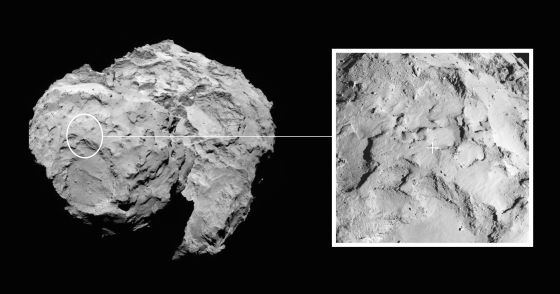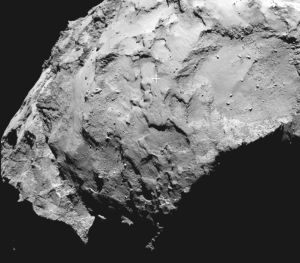
Location of the site chosen for the descent of the probe Philae, the Rosetta mission on the surface of 67P / Churyumov-Gerasimenko.
/ ESA / Rosetta / MPS for OSIRIS Team MPS / UPD / LAM / IAA / SSO / INTA / UPM / DASP / IDA
November 11, for the first time a spacecraft will land on the surface of the nucleus of a comet 67P / Churyumov-Gerasimenko . The Philae , which goes hooked on European spacecraft Rosetta , is making a risky maneuver that will last about seven hours, culminating with the appliance 100 kilos nailed to the ground with harpoons, for attachment to a body of low gravity. Scientists and engineers have chosen the mission this weekend the place, called J, for the descent from five options that were shortlisted, combining scientific interest to the technical and safety requirements of the probe. “The site offers the opportunity to explore pristine material characterize the properties of the nucleus [comment] and study the processes of their business,” said Jean Pierre Bibring, one of the leaders of the mission.
The bussling J (the name corresponds to the order of the first list was made of possible point drop) is in what has been called the head of the comet, shaped with two lobes, like a duck rubber, has surprised scientists when they have seen it get close to the ship Rosetta and send images of this celestial object four kilometers in maximum diameter. As a backup location, experts have chosen the C lobe is called the body of 67P / Churyumov-Gerasimenko
.

illustration `Philae’ lander on the surface of the comet 67P / Churyumov-Gerasimenko.
/ ESA / AOES Medialab
“From what we have seen in recent close images, the comet but it’s a nice dramatic world; is scientifically exciting, but its shape makes operations there be a real challenge, “he says Stephan Umalec responsible module Philae , in a statement from the European Space Agency (ESA). “None of the candidate landing sites meets all operational criteria 100%, but the J is clearly the best solution.”
The most outstanding place in J are not too pronounced, which reduces the risk that the probe tip on landing, and get enough light from the sun to recharge the batteries. “No one has tried before landing on a comet, so it’s a real challenge,” says Fred Jansen, head of the ESA mission whose cost amounts to one 1,300 million euros. “The complicated double structure of [67P / Churyumov-Gerasimenko] has had a considerable impact on the overall risk of landing, but they are risks worth taking for a chance to make the first soft landing on a comet.”
Experts, who last weekend met at the French Space Agency (CNES) to study the five possible landing sites that were the final candidates have had to assess and balance on the one hand, the Scientific interest in each site and, secondly, the amount of visible, besides the orbital dynamics obstacle to reach the ground and the positions of the probe and the vessel. Also keep in mind the hours of daylight and the right position to ensure smooth communications Philae with the ship Rosetta , which will be circling the comet, and . latter with Earth

Location decrease (marked with a cross) of Philae probe into the comet’s surface.
/ ESA / Rosetta / MPS for OSIRIS Team MPS / UPD / LAM / IAA / SSO / INTA / UPM / DASP / IDA.
“Any site of this comet has a very large interest for scientists,” said El Pais, Laurence O’Rourke, one of the coordinators of scientific operations Rosetta . “But the site chosen J is interesting, first, because scientists have seen that there is some activity in one of the smaller craters nearby, which means that while it is less than what we see in the neck of the comet landed if there we will see that activity closely, about 500 meters away, “he explains. “Second, J is the best place for Consert radar instrument, which has a share in the ship Rosetta and a Philae”, continues. “Third, and most important, is that the lander Philae the main battery used for the landing and the early days of scientific activity (the decline will last seven hours), but the lighting of the Sun in J means that there are opportunities to continue to work longer using the secondary battery receiving the charge from the solar panels, “adds O’Rourke.
The selection of suitable landing sites has been done in a few weeks, since until the Rosetta was not bringing enough to 67P / Churyumov-Gerasimenko to take good pictures and data was not enough to determine in advance the landing information. J point selection will be confirmed within 10 days, when you have made more path analysis
Rosetta , which left Earth in March 2004, has been making a complex maneuvers to approach the surface of the celestial object, since he arrived on 6 August, and is now about 30 miles. By going closer to the Sun, the comet 67P / Churyumov-Gerasimenko is gaining activity.
November 11, the Philae must execute the land on a comet ever attempted before . With all the commands from the control center and stored on your computer, perform a passive descent, taking pictures, since the release of the Rosetta and is directed to the target area, predetermined as an ellipse a few hundred meters, explains ESA. When you reach the ground will use their harpoons to engage the ground and avoid going out bounced (given the low mass of the comet, its gravity does not catch on the floor.)
Your first mission will be to make a panoramic image and send to Earth for scientists and engineers to determine where and orientation. Then, if all goes well, will begin scientific proper phase of Philae , analyzing plasma and magnetic environment, measuring temperatures and drilling on the floor to take samples analyzed in the laboratory to board. The radio broadcast waves to the ship Rosetta will reveal the interior structure of the comet.
No comments:
Post a Comment